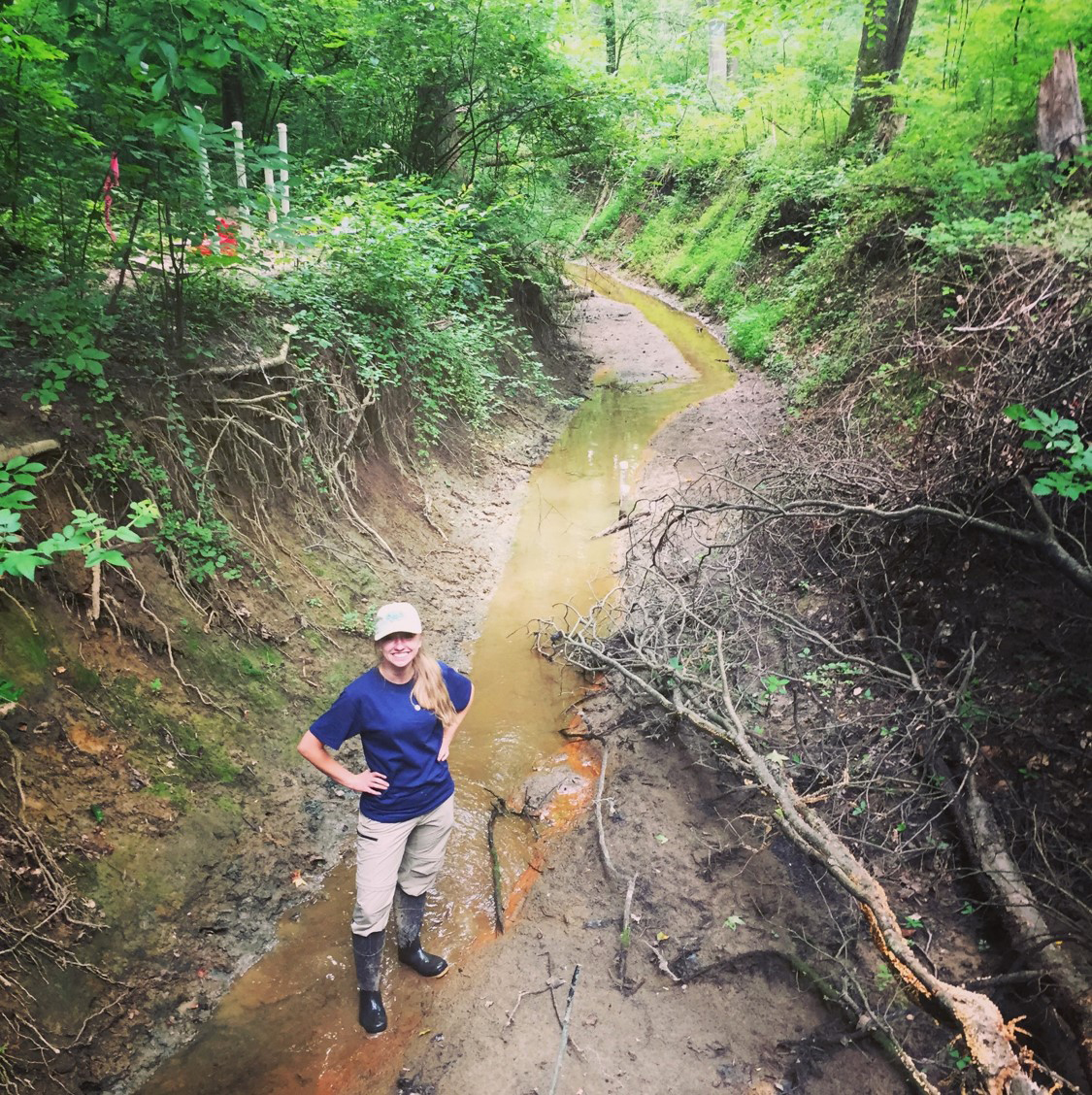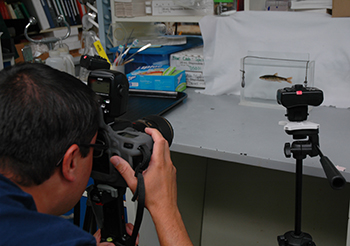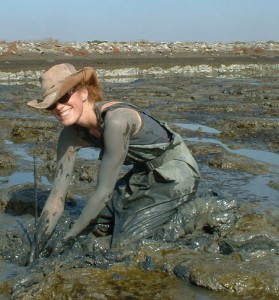Posted by Kristen Goodhue on November 23rd, 2015
by Kristen Minogue

SERC Intern Julianne Rolf stands in the streambed of Muddy Creek. Erosion has caused it to drop 10 feet below its floodplain. (SERC)
In the forests of Edgewater, Md., a stream called Muddy Creek is sinking. By itself this is hardly news. The Chesapeake’s ailing streams span thousands of miles, and the watershed’s states have devoted hundreds of millions of dollars towards trying to restore them. It’s part of a gargantuan effort to clean up the Chesapeake. Sick streams create a sick bay, and environmental managers are anxious to stem the nutrient and sediment overload from streams. But for all the zeal surrounding stream restorations, their success rate hasn’t always lived up to the hype. How effective can they be—and what do they need to succeed?
Fortunately, this stream happens to be under the watch of scientists. And the restoration of Muddy Creek may yield some answers. Click to continue »
Posted in Publications | 2 Responses »
Posted by Kristen Goodhue on November 16th, 2015
by Kristen Minogue

Frozen methane bubbles in an Alaska lake. When icy permafrost thaws, microbes are able to consume the carbon stored there and turn it into methane gas. (Miriam Jones/USGS)
We’ve underestimated greenhouse gases. Not carbon dioxide, arguably the most famous greenhouse gas except water. But others, like methane, are less abundant but more powerful in terms of trapping heat. And our figures about that have probably skewed low.
Carbon dioxide (CO2) comprises a staggering three-fourths of global greenhouse gas emissions, making it a major driving force behind climate change. But methane (CH4), long locked in Arctic permafrost, is escaping as ice thaws. Methane also enters the atmosphere via natural gas, livestock, coal mining, oil and even wetlands.
For years scientists and policymakers have reported that methane is roughly 30 times more powerful than CO2 over a century. This fall, two biogeochemists tested a more accurate model and discovered the true figure is far higher – more like 45 times more powerful than CO2.
The good news? Taking methane out of the atmosphere makes an even bigger difference than putting it in. Click to continue »
Posted in Climate Change, Ecology, Publications | 4 Responses »
Posted by Kristen Goodhue on November 10th, 2015
by Heather Soulen

Rob Aguilar takes photos of all DNA barcoding reference specimens they collect in the Chesapeake Bay
Rob Aguilar of SERC’s Fish and Invertebrate Ecology Lab co-authored a DNA barcoding paper this past September in the journal Environmental Biology of Fishes. Rob spoke with us about his paper and the DNA barcoding work going on in the Fish and Invertebrate Lab. While the term DNA barcoding may seem difficult to understand, it’s easiest to think about it as a uniquely identifiable species level code.
Click the sound file below to listen to the interview.
Additional barcoding details are available in the full podcast transcript.
Click to continue »
Posted in Ecology, Fisheries, Interviews, Invasive Species, Publications | 1 Response »
Tags: barcoding, catfish, DNA, fish, invasive species, predator
Posted by Kristen Goodhue on November 4th, 2015
![Erica Staaterman in the [X] with baby [X].](data:image/svg+xml,%3Csvg%20xmlns='http://www.w3.org/2000/svg'%20viewBox='0%200%20300%20225'%3E%3C/svg%3E)
Erica Staaterman selfie with a baby larval snapper. (Erica Staaterman)
by Kristen Minogue
Dr. Erica Staaterman listens to the ocean for a living. Often seen as a silent landscape broken only by whale or dolphin songs, Staaterman is helping uncover a wealth of noise from the ocean’s hidden creatures, first in California and now in the Chesapeake as a postdoc for the Smithsonian Environmental Research Center. Learn more in the edited Q&A below, and click the sound files to hear some of the secret sounds of the sea.
How did you get into acoustic ecology?
My first research job out of my undergrad was working for Sheila Patek at UC Berkeley….She had a bunch of recordings of these [California spiny] lobsters making sound, and nobody really understood why they make sound. So we did an experiment where we tried to understand the function of the sounds made by these lobsters. So anyway, that was sort of my first foray into acoustics, and from there I just thought it was really fascinating.
In California, you described researching a chorus of mantis shrimp. What did that sound like?
We called them rumble groups. Sometimes they would have two rumbles per group, sometimes three rumbles per group, sometimes four or five….At dawn and dusk you would hear so many different rumble groups occurring at the same time that they would all be sort of overlapping, and it seems to indicate that there are many individuals making sound at the same time, just the way birds all sing out at once in air.
Listen below: Mantis Shrimp “Rumble Groups” Click to continue »
Posted in Ecology, Fisheries, Interviews | 4 Responses »
Posted by Kristen Goodhue on October 31st, 2015
The Devil You Know
by Heather Soulen
In our last installment of The Dark Side of Taxonomy, we’ve saved one of the most fear inducing scientific names for last. We wouldn’t have done due diligence this Halloween season if we didn’t mention him. In this piece we present a small collection of organisms that in some instances have suffered the same etymological fate – a scientists with a proclivity for dark humor. Here we spotlight organisms that carry the infamous name of an angel who fell from grace.
Click to continue »
Posted in Publications | Comments Off on The Dark Side of Taxonomy: Part Three
Posted by Kristen Goodhue on October 30th, 2015
by Heather Soulen
Darker Still
Delving deeper into the dark side of taxonomy, we forge forth into the ether to uncover obscure and wickedly inspired scientific names. What’s in a scientific name? As described in The Dark Side of Taxonomy: Part One, some scientific names for organisms have dark and twisted origins. In part two of this three-part series, we peek behind the thin gauze-like veil, fearlessly sifting through time and lore to deliver a new collection of gruesome scientific names. Here we share ancient tales of Greek mythology, an Italian literary genius from the Middle Ages and the unforgiving Underworld.
Click to continue »
Posted in Classes and Events, Education, Fisheries, Publications | Comments Off on The Dark Side of Taxonomy: Part Two
Tags: binomial nomenclature, Dante, fish, Greek mythology, Hades, Halloween, Hell, Inferno Pergatorio, moth, scientific names, Taxonomy
Posted by Kristen Goodhue on October 28th, 2015
By Heather Soulen
In the spirit of the Halloween season, we’ve decided to showcase some of the more darkly inspired scientific names. But first, what exactly is a scientific name, and how did it come to be? In the 18th century, Carl Linnaeus developed a hierarchical naming system known as Linnaean classification for categorization of organisms. As part of his classification system, Linnaeus introduced binomial nomenclature, a formal system for giving organisms a two-part scientific name. The first part of the name is a word that identifies the genus to which a species belongs. The second part of the name is a word that identifies a species within a genus. Scientific names are often in Latin, Greek or some other ancient or classical language, and may reflect some special aspect or feature of that organism. For example, an organism with stripes, bars or a mottled appearance may have a species name of variegatus, Latin for variegated.
However, some scientific names have Latin and Greek words that are less innocuous. Some words conjure up images of terror and the occult. When whispered, the names seem to slither like a snake over the tongue – sending chills down spines and making hairs on the back of the neck rise like ghosts from a grave. This week we delve into science’s darker and more twisted scientific names.
Click to continue »
Posted in Education | 3 Responses »
Tags: binomial nomenclature, Carl Linnaeus, Halloween, scientific names, spells, vampire
Posted by Kristen Goodhue on August 28th, 2015
by Heather Soulen
The Need for Healthy Marshes
Ten years ago, on August 28, 2005, Hurricane Katrina nicked south Florida and entered the heat-charged waters of the Gulf of Mexico, transforming from a Category 1 hurricane into a super-charged Category 5. In the early morning hours of August 29, it ripped through Louisiana and Mississippi. Thousands died, and hundreds of thousands of homes and businesses were destroyed. Today, much of the Louisiana and Mississippi coasts, and its people, are still recovering from the devastation.
When Katrina hit, some coastal marshes east of the Mississippi River lost approximately 25 percent of their area. In the decade that followed, salt marshes and wetlands in Louisiana have continued to disappear in some places, but not others. The scientific community soon zeroed in on keeping marshes healthy, since, as one scientist remarked “A healthy marsh is pretty resilient, A stressed marsh – storms will physically break the marsh down.” Marshes and wetlands are ecologically and economically important ecosystems. During storms they act like buffers, reducing storm surge and flood damage, but only if they’re healthy. The question is, what factors make a marsh strong or weak?
Click to continue »
Posted in Climate Change, Ecology, Invasive Species, Land Use, Publications | Comments Off on Remembering Hurricane Katrina by Studying Marshes of the Future
Tags: carbon dioxide, climate change, genetic diversity, Hurricane Katrina, hurricanes, management, marsh, nitrogen, nutrients, sea-level rise, Spartina
Posted by Kristen Goodhue on August 21st, 2015

Lisa Koetke prepares a motion-activated camera. (Courtesy of Lisa Koetke)
by Chris Patrick
Imagine a swimming creature. It holds an antlered head above the water as its skinny, hooved legs tread underneath. A black stripe runs from its head to its tail, outlining a waggling white rump, revealing it to be a sika deer.
In 1916, a man named Clemment Henry released between four and six sika (the number isn’t certain) for hunting on James Island, off Maryland’s Eastern Shore. But it turns out sika are great swimmers—by 1962 they migrated to the Delmarva Peninsula and they now occupy every county of the lower Eastern Shore. Click to continue »
Posted in Ecology, From the Field, Interns, Invasive Species | Comments Off on Bucket Buffets Divulge Deer Preferences
Posted by Kristen Goodhue on August 20th, 2015
The newest climate change research tool may be in your pantry

Lisa Schile in a marsh in San Francisco.
(Courtesy of Lisa Schile)
by Chris Patrick
Tea bags are no longer merely a means of brewing an aromatic beverage. They’ve now found purchase in environmental research, providing a more efficient way to measure how fast things decay—and how well wetlands store carbon.
Lisa Schile, a postdoc in the biogeochemistry lab at the Smithsonian Environmental Research Center (SERC), said she’s a “guinea pig” for tea bag research. Schile puts tea bags into wetlands not because she’s vying for the record of World’s Largest Cup of Tea, but because tea bags are essentially mini litter bags, buried mesh sacks of leaves and other plant parts that tell researchers how fast plants decompose in an area. Click to continue »
Posted in Climate Change, Ecology, From the Field, SERC Sites and Scenes | 3 Responses »





![Erica Staaterman in the [X] with baby [X].](https://sercblog.si.edu/wp-content/uploads/2015/11/withbabyfish_brightened.jpg)

